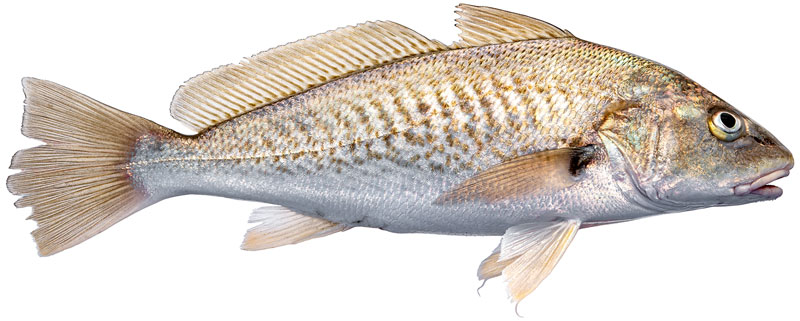
Download the mobile app!
Hooking Up Anglers Since 2011.
Check out our new Android or iOS app for Fishing Status.
The long awaited return of our mobie app is back on Apple App Store and Google Play
Atlantic Croaker
Species Information
| Scientific Name: | Micropogonias undulatus |
| Common Names: | croaker |
| Environment: | Inshore, Surf |
| Ideal Temp: | 48-90°F (9–32°C) |
About Atlantic Croaker
Atlantic croaker are about 12 inches (30 cm) long and weigh 1/2 to 2 pounds (226 g to 0.9 kg) on average. Its distinguishing characteristics include three to five pairs of small barbels or "whiskers" on their chins to help them feel for food on the sea floor; a lateral line that extends to the tip of its caudal (tail) fin; inferior mouth (located to the bottom of the head facing the ground), and brown vertical stripes on its sides. Adults are silver with a pinkish cast, while young are silvery and iridescent. Older fish are brassy in color with vertical brown streaks formed by spots that are on their scales.
The Atlantic croaker is a very important commercial fish. Millions of pounds are caught and sold every year in the United States and exported to other countries. The annual catch of croaker has declined in the past few years, probably due to over fishing. The best times for fishing for Atlantic croaker are from summer into the fall. They are easily caught on bait (dead shrimp) when fishing on the bottom. Small Atlantic croaker are used as a bait fish to catch other fish, especially spotted seatrout (Cynoscion nebulosis) and crabs.
Atlantic croaker "croak" by vibrating their swim bladders with special muscles as part of their spawning ritual. A swim bladder is a pocket full of air inside the fish that helps keep it afloat and facing upright. This behavior attracts females. Along the Gulf Coast, they reach sexual maturity at about one year old. This varies in other areas. Spawning season is in the fall, with a peak between August and October. During spawning season, females will release between 100,000 and 2 million eggs, each about 0.35 mm in diameter. After hatching, the larvae (immature stage) drift toward land. They are abundant on soft bottoms, such as mud, where there are large amounts of detritus for them to feed on. The Atlantic croaker's diet includes shrimp, crabs, and detritus (dead and decomposing plant and animal matter).
Atlantic croaker can live up to eight years. Their predators include striped bass, shark, spotted seatrout, other croakers, and humans. Croaker that live in the northern part of their range mature later and live longer than those in the southern part of their range. Because of predation, more than 95% of the Atlantic croaker population dies every year. Atlantic croaker should not be eaten raw because they may pass trematodes (parasites) to humans. The croaker is closely related to spotted seatrout and red drum.
Habitat
Atlantic croaker prefer estuaries and bays through the spring and summer, then travel offshore in the fall to breed.
Distribution
The Atlantic croaker is found on the Atlantic coast from Massachusetts southward and throughout the Gulf of Mexico.
Atlantic Croaker Fishing
| World Record: | 3.94 kg (8 lb 11 oz) Chesapeake Bay, Virgina, USA 17-Aug-2007 Norman T. Jenkins |
| # Fish Caught: | 8209003 documented in database. |
| Earliest Record: | 1/1/1830 12:00:00 AM and located at 28.45915, -96.79089. |
| Latest Record: | 4/2/2025 8:55:12 AM and located at 36.20031, -75.76470. |
| Common Techniques: | Bottom Fishing |
| Popular Lure Types: | Bottom Rig |
| Fishing Spots: | 278 Atlantic Croaker fishing spots. |
Latest Atlantic Croaker Fishing Reports and Spots
96 Recfishwest's Statewide Fishing Report - 14 November 2025 All the best tips and photos on what's biting across WA including forecasts gear u (
View)
96 Recfishwest's Statewide Fishing Report - 21 November 2025 All the best tips and photos on what's biting across WA including forecasts gear u (
View)
96 Recfishwest's Statewide Fishing Report - 07 November 2025 All the best tips and photos on what's biting across WA including forecasts gear u (
View)
Monday September 29 2025 Fishing Report It wasn’t the most beautiful weekend we could have asked for but the fish didn’t seem to mind whether th (
View)
Note: The last few days we've had the last of an outgoing tide and we've been getting Redfish at drainages and cuts between oyster beds - handf (
View)
Boy what a pretty day we had...sunshine just a slight breeze and mild temperatures. I had met Brian Ahrens and his sons Henry and Oscar down a (
View)
96 Recfishwest's State-wide Fishing Report - 26 September 2025 All the best tips and photos on what's biting across WA including forecasts gear (
View)
96 Recfishwest's State-wide Fishing Report - 12 September 2025 All the best tips and photos on what's biting across WA including forecasts gear (
View)
We knew that the wind was supposed to pick up today as we fished so we got out early and got some good catches in before it really picked up. (
View)
Boy you can feel that fall weather in the air! It wasn't quite nippy this morning but it definitely was a bit cooler which made for a fine fish (
View)